Standard [CURRENT]
ASTM E 3258:2025
Standard Guide for Evaluation of Changes to the Thermal, Moisture and Ventilation Performance of Existing Roof Enclosures (with Vented or Sealed Attic or Rafter Spaces)
- Publication date
- 2025
- Original language
- English
- Pages
- 9
- Publication date
- 2025
- Original language
- English
- Pages
- 9
- DOI
- https://dx.doi.org/10.1520/E3258-25
Product information on this site:
Quick delivery via download or delivery service
Buy securely with a credit card or pay upon receipt of invoice
All transactions are encrypted
Short description
1.1 This guide covers the evaluation of hygrothermal impacts to existing roof enclosures resulting from roof enclosure alterations or changes to the interior environment. Examples of alterations that may affect the hygrothermal performance include but may not be limited to: installation of or alterations to insulation, installation of air or vapor retarders, alterations to the ventilation openings of naturally ventilated attic space or installing mechanical attic ventilation, or any other alterations that could impact the drying potential, ventilation, thermal performance, or vapor resistance of the roof enclosure. Examples of interior environment changes that may affect the hygrothermal performance include but are not limited to: changes in occupancy, mechanical conditioning of a previously unconditioned space, adding habitable space within an existing attic space, or any other alteration that will impact the temperature, relative humidity, or air flow beneath the existing roof deck. 1.2 This guide is intended to address the hygrothermal impacts of a retrofit to an existing roof enclosure which originally contained naturally ventilated or unconditioned attic or rafter spaces. 1.3 This guide can be used as a part of an evaluation to assess the cause of moisture-related issues impacting the structure beneath an existing roof enclosure suffering from moisture accumulation related issues, including impacts on roof rafters, trusses, and joists. 1.4 This guide is not intended to address the installation, maintenance, or replacement of roof covering materials. 1.5 This guide does not include provisions for structural evaluation of the existing roof enclosure. Changes to the roof loads, including dead and live loads, need to be evaluated outside of the provisions of this guide. 1.6 This standard does not purport to address all of the safety concerns, if any, associated with its use. It is the responsibility of the user of this standard to establish appropriate safety, health, and environmental practices and determine the applicability of regulatory limitations prior to use. 1.7 This international standard was developed in accordance with internationally recognized principles on standardization established in the Decision on Principles for the Development of International Standards, Guides and Recommendations issued by the World Trade Organization Technical Barriers to Trade (TBT) Committee.
ICS
91.060.20,
91.100.50
DOI
https://dx.doi.org/10.1520/E3258-25
Also available in
Loading recommended items...
Loading recommended items...
Loading recommended items...
Loading recommended items...

